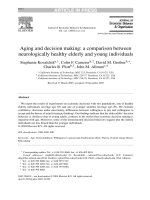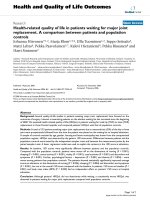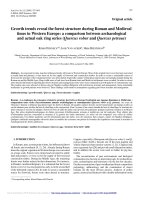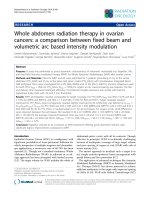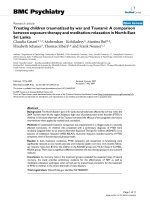New a comparison between hiv and sars cov2
Bạn đang xem bản rút gọn của tài liệu. Xem và tải ngay bản đầy đủ của tài liệu tại đây (39.71 KB, 7 trang )
Biology:
Essay Assignment
Due:
Word Count: 1180
Challenges of developing vaccines: A comparison between HIV and
SARS-CoV2 Considering both specific viral life cycles and types of
associated pandemics, discuss the key reasons that can help explain why
several vaccines against Sars-CoV-2 have been developed in record time, but
there is still no vaccine against HIV forty years after its emergence.
We have experienced two pandemics in the last half-century: the
human immunodeficiency virus (HIV) and the critical acute respiratory
syndrome coronavirus 2 (SARS-CoV-2) infections. Both are caused by
biological viruses that have reached us from animals (Wu A et al.2019).
Although these two viruses are distinct in the transmission mode and the
symptoms they generate, they have significant similarities., we have
experienced two pandemics, the human immunodeficiency virus (HIV) and
the severe acute respiratory syndrome coronavirus 2 (SARS-CoV-2)
infections. Both are caused by biological viruses that have reached us from
animals. This paper will compare HIV and SARS-CoV2 while scrutinizing
the key reasons that explain why several vaccines against Sars-CoV-2 have
been developed in record time. However, there is still no vaccine against HIV
forty years after its emergence.
HIV infection was found in the 80s (1981), when the first cases were
known in young adults in California. It is supposed that HIV spread to
humans through direct contact with the infected blood of chimpanzees by
hunting them for their meat (Lu R et al.2020). Although there is no remedy
for HIV infection, effective antiretroviral therapy (ARTs) can regulate the
virus and help prevent transmission to other people.
In the case of SARS-CoV-2, the first cases were stated in December
2019 in Wuhan, in the Chinese province of Hubei (Montoya WR et al., 2012).
There were 41 cases of people with pneumonitis, 66% of whom had a
workday in a seafood market where all kinds of fish and meat were sold, so it
is thought that the source might be there. On March 11th, 2020, when globally
confirmed cases exceeded 118,000, and the number of deaths was 4,291, the
WHO characterized the SARS-CoV-2 infection as a pandemic named
CoronaVirus (COVID-19). From that day on, most countries have suffered
the infection, and it is not yet controlled.
About Specific viral Life circles, on the first hand, Coronavirus( SARSCoV2) is transmitted through the air, mainly due to tiny drops of saliva from
infected people by coughing or sneezing that can reach two meters (Zhu N et
al.2019). The symptoms generated by SARS-CoV-2 begin to emerge between
2 and 14 days after contact with the virus. The most typical symptoms include
cough, fever, and dyspnea. Diarrhea and abdominal pain are also frequent.
Although most cases have mild symptoms, the infection can cause
pneumonia, kidney failure, severe difficulty breathing, and even death in the
most rigid cases.
On the other hand, The symptoms generated by HIV infection begin to
appear between 2 and 6 weeks after contact with the virus. They can be
divided into an early infection (within the first two months after infection) or
chronic (Tortorici et al., 2019). Infected people present fever, muscle pain,
headache, rashes, sore throat and mouth sores, and swollen lymph nodes
during the infection's early or acute phase. These symptoms can be so light
that they are almost not noticed. In the phase of chronic infection, the virus
continues
expanding
and
destroying
immune
cells,
inducing
immunosuppression. Typically, if it is not treated, HIV turns into AIDS in an
average of 10 years. When AIDS befalls, the immune system is already
seriously damaged, opportunistic infections, neurodegenerative diseases and
cancers transpire in infected individuals.
COVID-19 seems not to be very distinct from SARS regarding its
clinical features. Though, it has a fatality percentage of 2.3%, lower than that
of SARS (9.5%) and much lower than that of MERS (34.4%)(N Petrosillo et
al.2020). The possibility cannot be dismissed that the less severe clinical
picture of COVID-19 can grow in the community more quickly than MERS
and SARS. The actual primary reproductive number (R0) of COVID-19 (2.02.5) is still debatable. It is probably slightly higher than the R0 of SARS (1.7-
1.9) and higher than that of MERS (<1). A gastrointestinal route of
transmission for SARS-CoV-2, assumed for SARS-CoV and MERS-CoV,
cannot be ruled out and needs further investigation.
Currently, there are three main types of Sars Covi 2 vaccines that are
authorized and promoted or undergoing large-scale clinical trials in the United
States. They are mRNA vaccines, Protein subunit vaccines and Vector
vaccines.
mRNA vaccines include material from the virus that causes COVID19, giving cells instructions for making a harmless protein unique to the virus.
They destroy the biogenetic material from the vaccine. Our bodies recognize
that protein and build T-lymphocytes and B-lymphocytes to remember how to
fight against the virus that causes COVID-19.
Protein subunit vaccines include weak pieces (proteins) of the virus that
causes Sars Cov 2 instead of the entire germ. Once vaccinated, bodies will
build T-lymphocytes and antibodies to remember how to fight the virus that
causes COVID-19.
Vector vaccines include a modified version of a more complex virus
than the one that causes Sars Cov 2. Inside the shell of the modified virus,
there is material from the virus that causes Sars-cov 2. Once the viral vector is
inside our cells, the generative material gives cells instructions to make a
unique protein to the virus that causes COVID-19. This prompts our bodies to
build B-lymphocytes and T-lymphocytes that will memorize how to fight that
virus if we are infected in the future.
Today, millions of people have been saved because of the rapid
deployment of effective vaccines against COVID-19 (Lu R et al.2020).
Nevertheless, it has been 40 years since HIV was discovered as the cause of
AIDS, and there is no vaccine. First and foremost is the continuous merciless
virus replication (Tortorici et al., 2019). HIV has evolved the ability to
generate and tolerate many mutations in its genetic information. The outcome
of this is an enormous amount of variation among strains of the virus from
one individual to another and even within a single individual. The variability
of HIV within a single infected individual exceeds the worldwide sequence
variability in the influenza virus during an entire season.
HIV has also grown an incredible ability to shield itself from
recognition by immunoglobulins. Enveloped viruses such as coronaviruses
and herpes viruses encode a structure on their outside that each virus uses to
enter a cell. This structure is called a "glycoprotein," indicating that it is
composed of sugars and protein. However, the HIV envelope glycoprotein is
extreme. It is the most heavily sugared protein of all viruses in all 22 species.
More than half the mass is sugar. Moreover, the virus has figured out a way,
meaning the virus has developed by natural selection, to use these sugars as a
shield to protect itself from recognition by antibodies that the infected host is
trying to make.
In conclusion, this paper would like to point out that although these
viruses do not resemble each other at first sight, the molecular mechanisms
used are familiar: the rise of pro-inflammatory cytokine synthesis, the
modifications in intestinal microbiota, and the NETs formation. Basic science
has been trying to understand these mechanisms for years, and the more
significant the knowledge, the lesser the damage to the population in this
pandemic and the future.
REFERENCE
1. Wu A, Peng Y, Huang B, Wang X, Ding X, Niu P. et al. Genome
Composition and Divergence of the Novel Coronavirus. Originating in China.
Cell Host Microbe. 2020;27(3):325–8. [PMC free article] [PubMed] [Google
Scholar]
2. Lu R, Zhao X, Yang B, Wu H, Li J, Niu P. et al. Implications for
virus origins and receptor binding. Lancet. 2020;395(10224):565–74
3. Zhu N, Zhang D, Wang W, Yang B, Song J, Li X. et al. A Novel
Coronavirus with Pneumonia in China. Engl J Med. 2020;382(8):727–33.
4. Wu F, Zhao S, Wang W, Song ZG, Yu B, Chen YM, et al. A new
coronavirus
associated
with
respiratory
disease
in
China.
Nature.
2020;579(7798):265–9.
5. Abbas AK, Lichtman AH, Pillai S. Cellular and Molecular
Immunology, ninth ed, Elsevier Health Sciences, Philadelphia, 2017.
6. Rein A. RNA Packaging in HIV. Trends Microbiol. 2019;27(8):715–
23.
7. Towers GJ, Noursadeghi M. Interactions between HIV-1 and the
cell-autonomous innate immune system. Cell Host Microbe. 2014;16(1):10–8.
8. Tortorici MA, Structural insights into coronavirus entry. Advances in
Virus Research. Elsevier Inc. 2019. p:93-116.
9. Montoya WR, Anaya JM. Inmunología de Rojas, sixteenth ed.
Corporación para Investigaciones Biológicas. 2012.
10. Grupo de Estudio del SIDA-SEIMC (GESIDA) />
11. Trono D, Van Lint C, Rouzioux C, Barré-Sinoussi F, Verdin E,
Chun TW. et al. HIV persistence and the prospect of long term drug-free
remissions for HIV-infected individuals. Science. 2010;329(5988):174–80
12. Song Z, Xu Y, Bao L, Zhang L, Yu P, Qu Y, From SARS to
MERS, thrusting coronaviruses into the spotlight. Viruses. 2019. 11(1)
13. Cui J, Li F, Shi ZL. Origin and evolution of pathogenic
coronaviruses. Nat Rev Microbiol. 2019;17(3):181–92.
14. Hamming I, Timens W, Bulthuis MLC, Navis GJ, van Goor H,
Lely AT. Tissue distribution of ACE2 protein and the functional receptor for
SARS coronavirus. The first step in understanding SARS pathogenesis. J
Pathol. 2004;203(2):631–7.
15. N Petrosillo, G Viceconte, Ergonul, G Ippolito, E Petersen. SARS
and MERS and COVID-19, are they closely related?. 2020


